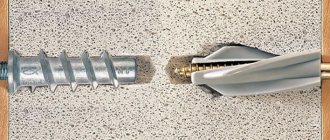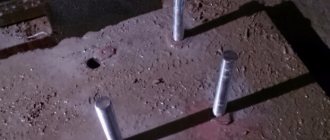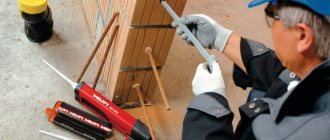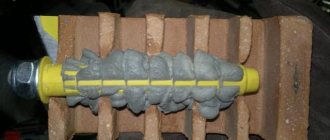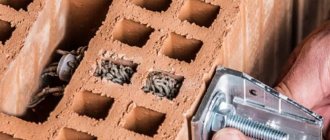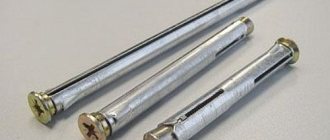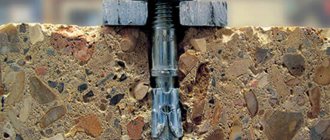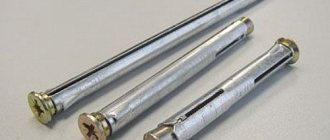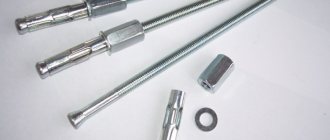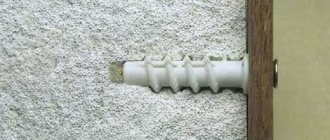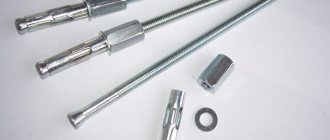Last year, my friend faced a small but unpleasant problem. He decided to hang the TV on the wall. I did the work, praised myself, and went safely on a business trip. I was absent for a couple of months. I arrived home, and his TV died the death of the brave. Why didn't good dowels fulfill their function?
It turned out to be simple: the walls are made of porous raw materials - aerated concrete! And, as you know, it requires the use of a reliable fastening system. I advised him to try using a chemical anchor for foam concrete (although there are other tricks). That same day, of course, he tested it. What can I say? The TV has been on the wall for over a year now, no problems. That is, the fastener can withstand the load perfectly.
I would like to introduce you, dear friends, to this miracle product. Shall we start?
Chemical anchor: product features
So, what is it and what is it eaten with?
Concept
A chemical anchor (adhesive anchor) is a device consisting of a metal rod and a two-component synthetic resin. It penetrates the cells of the raw material with lightning speed, promoting a reliable and strong connection between the fixing product and the base.
Components
Of course, the proportions of the chemical composition of a product are a trade secret of manufacturing organizations. But in general, the product contains:
- artificial resin based on acrylic, polyurethane, polyester;
- quartz sand;
- cement;
- hardener.
In principle, you can create this substance with your own hands, but this is a topic for another discussion.
Normative documents
Calculations, laboratory tests and many years of application experience have confirmed the reliability and strength of the resulting connection under a wide variety of operating conditions. In the European Union, this type of fastening is approved for use by the European Technical Regulation ETA TR 023 “Evaluation of glued-in reinforcement” and the Common European Building Technical Code EU2, which allow the design and calculation of glued-in reinforcement as pre-concrete reinforcement.
For use in the territory of the Customs Union, design standards are regulated by standard STO 36554501−048−2016 “Anchoring to concrete. Design Rules". The standard includes separate annexes “Normalized parameters and coefficients for calculating anchors” from manufacturers such as Hilti and Fischer. The appendices contain methods for calculating the strength of a connection based on numerous mechanical parameters: under the action of tensile and shear forces, based on the contact of the anchor with the base, when breaking out the concrete of the base, when breaking off the edge of the base, and so on.
These documents can also be useful for non-professionals - using the tables, you can correctly determine the requirements for installing a chemical anchor for your operating conditions and loads, and select the necessary chemical anchor for aerated concrete or brick, a concrete base, depending on its brand or condition.
Scope of application
The chemical anchor holds perfectly in thickness:
- expanded clay concrete;
- aerated concrete;
- foam concrete;
- foam silicate;
- gas silicate;
- foam magnesite;
- gas magnesite;
- foam gypsum;
- gas gypsum.
It is clear that a conventional fastening system on a surface made from this raw material is ineffective. But a chemical anchor is exactly what you need. By using it, you can be sure that it will not fail at the most inopportune moment.
The product is used for fastening:
- monolithic structures;
- brackets;
- reinforcement outlets;
- utilities and engineering networks;
- flights of stairs;
- facing materials;
- fencing on the road (finished) surface;
- household and sanitary equipment;
- industrial units;
- decor items.
The areas of application are countless. But one thing can be said - the technical characteristics of the product open up new opportunities in construction.
Types of anchors
Chemical anchors represent a serious alternative to mechanical anchors. It is able to provide increased load-bearing capacity and ensure reliable fixation without the occurrence of deformation stresses in the cellular mass.
Chemical anchors for concrete consist of a chemical resin and hardener
The anchor for aerated concrete is offered by manufacturers in various packaging, representing:
- individual capsules or ampoules intended for single use;
- cartridges of increased volume, which can be equipped with a special gun, and are used repeatedly.
A chemical anchor for cellular concrete has different properties depending on the compositions used to fill the drilled hole. Applicable:
- Epoxy based resins.
- Vinylester compounds.
- Polyester binders.
- Epoxy acrylate fillers.
Let us dwell in detail on the characteristics of resins.
Epoxy-based resins are used to secure elements of process equipment and fasten beams. They are characterized by:
- possibility of use in environments with high humidity;
- hardening duration ranging from 8 hours to 2 days;
- absence of internal stresses of aerated concrete during hardening of the composition.
Many companies produce adhesive mixtures without such a toxic component as styrene. This makes it chemically safe
Vinylester compounds are used to provide facade fastening. Distinctive features:
- Resistance to negative temperatures.
- Effective fastening of threaded elements and smooth fittings.
- The absence of harmful substances allows you to perform work safely.
- Hardening occurs throughout the day.
Polyester-based fasteners provide reliable fastening of fencing structures, facade elements and utilities. Basic properties:
- ensuring the fastening of only threaded fittings installed in conical holes;
- ensuring effective anchor fastening in rough holes;
- accelerated hardening, allowing the fastener to be used for 3 hours.
Chemical fillers based on epoxy acrylate are used for various purposes and differ:
- An increased level of fire resistance, ensuring the absence of deformation of fasteners for 2 hours when exposed to open fire.
- Can be used at temperatures not lower than -5 degrees Celsius.
- Achieving performance characteristics throughout the day.
The material from which it is made is resistant to chemical, atmospheric and corrosive influences
Let's dwell on the features of use.
Advantages
The product has a lot of advantages and a small cart, namely:
- durability;
- safety;
- multifunctionality;
- practicality;
- high strength;
- no odor;
- compatibility with any materials;
- ease of use;
- tightness of the hole after installation;
- no tensile stress;
- resistance to the destructive influence of chemical, thermal, mechanical, biological and climatic factors.
There are many obvious advantages, but there are also negative aspects.
Advantages and disadvantages
Like all fasteners, chemical anchors have pros and cons to their use. The undoubted advantages of this fastener are the tightness of its connection with the material and the ability to withstand significant loads. Also, the composition and structure of the chemical anchor prevent the appearance of cold bridges in the places where they are installed.
The fastener also has significant disadvantages, such as the impossibility of dismantling the chemical anchor after the composition has hardened, and its high cost.
There is also a need to correctly calculate the adhesive composition for installing the anchor. The consumption of the adhesive composition will increase in proportion to the porosity of the material into which the fastener will be installed. So a chemical anchor for concrete will require more adhesive than an anchor for brick.
Kinds
Chemical fasteners are:
- ampoule;
- capsule (injection) in tubes and cartridges.
The ampoule anchor is a miniature glass cylinder. It contains a resin that hardens upon contact with air. It does its job perfectly, but the ampoule is intended for only one hole. Everything would be fine, but! If the hole is relatively large, the resin will not be able to completely fill it. What does it mean? Elementary Watson! There will be very little substance in the hole, and the fastener will not withstand the load.
Capsule anchors in cartridges are represented by small containers with miniature spouts through which glue is squeezed into the hole. And the anchor in the tubes is a substance hidden in a large reservoir. To use it, you need to acquire a construction pistol.
Products are also classified according to the temperature of use. The following types of product are available:
- summer;
- winter;
- spring-summer-autumn.
Summer products are used at temperatures +5 – +40°C. Spring-summer-autumn products are used at temperatures of -10 – +40°C. Winter devices are designed to operate at temperatures of -26 – +20°C.
In view of this, it is necessary to pay attention not only to the appearance, but also to the temperature regime.
Anchoring technology
Fastening is based on the occurrence of a reaction between materials. Chemical solutions for work, polyester resin and hardener are supplied in two types of packaging (containers) - glass ampoules and tubes (cartridges). Their mixing causes chemical and physical fixation processes. The speed of fixation of the structure depends on the type of chemical composition of the mixture and the physical state (humidity, temperature) of the environment.
Ampoules .
The size of the ampoule is designed to achieve maximum loads on the fastener and corresponds to the size of the anchor. A hole of a given size is drilled, an ampoule is inserted into it, and then a pin is hammered or screwed in. The fasteners can be made locally or purchased from the company along with the ampoules. Ampoules are divided by diameter and used for fastening in holes of a certain size. Cartridges . In cartridges, the compositions are separated and, during extrusion, mixed inside a nozzle-nozzle, which has a special spiral design. They differ in size and layout of departments for trains. The composition is poured from the cartridge into the drilled hole using a special dispenser pistol. Advantage - they are used for fixing anchors in holes of any size, even those significantly exceeding its diameter.
Before installing the fasteners, the holes should be cleared of dust and dirt. When using a cartridge for hollow structures, a perforated polyester cartridge is first inserted into the hole. Due to the expansion of the solution flowing through the holes, additional fixation of the chemical anchor into the concrete is created in the wall of the cartridge.
It is possible to use cartridges as glue for fixing products made of different materials to each other. They are also used for repair work when filling cracks and holes.
Chemical stud anchor . Holes are formed symmetrically in the fixed working surfaces, which are filled with a chemical solution from the cartridge; ampoules are used less often. The products are connected through an inserted pin.
When working with large volumes and surfaces, components are supplied in cans. To apply them, special pumps and mixer attachments are used, and specially trained personnel are required for permission to work.
Chemical anchors are used as reliable fastenings in many areas of modern construction:
- road construction (installation of noise barriers, barriers, information boards, lighting masts);
- ventilated facades (used for fastening structures to hollow bricks and cellular concrete);
- installation of complex structures (balconies, consoles, columns, creation of reinforcement outlets);
- installation of more decorative structures (railings, canopies, lighting, stucco);
- advertising (used for installing signs, banners, banners, information structures);
- elevator service (repair and installation of shafts, equipment fastening, escalators);
- installation of auxiliary construction equipment (scaffolding, cranes);
- installation of industrial equipment (oil refining equipment, conveyors, machine tools);
- warehouses (racks, lifts, conveyors);
- assembly of buildings from blocks (attaching frames to foundations and blocks to them);
- strengthening the strength of the structure and foundations (metal structures, impregnation of masonry walls);
- restoration of buildings (used for installing floors, restoring masonry, attaching new structures to existing ones);
- offshore construction (ports, locks, oil terminals);
- water entertainment industry (water parks, swimming pools, etc.);
- airports (runways, mounting of antennas and navigation equipment);
- winter recreation industry (lifts, funiculars);
- energy (nuclear power plants, state district power plants, transformers, power line supports);
When choosing to use this type of fastener, a significant cost reduction is also taken into account. Savings reach up to 50% compared to using traditional types of anchors, especially when using large sizes. There is a reduction in inventories in the warehouse and a reduction in overhead costs due to the possibility of manufacturing anchors of any shape on the construction site, as well as reducing their total quantity in work per unit area of the fixed product. Thanks to its characteristics, any fastening work is easier and faster when using a chemical anchor.
Chemical anchors expand the horizons of construction. An increasing number of them are appearing on the market with new enhanced fixation properties.
On our website FORUMHOUSE you can read about the experience of using this type of fastener. Also read our article about traditional self-tapping screws, screws and anchors.
Editor: Adamov Roman.
This is interesting: How to choose the right drill for a dowel for fastening various objects
Installation
Fastening anchors is not likely to cause any difficulties. But if in doubt, read the instructions carefully.
The method of installing the ampoule product is very simple. We do the following work:
- determine the consumption of anchors (number of holes = number of anchors);
- drill a hole;
- we clean it of debris;
- place the ampoule in the hole;
- screw in the rod (stud anchor).
And then the following happens: the ampoule breaks, the adhesive composition flows out, filling the hole, and sets, and the fragments perform a reinforcing function.
To install a capsule product, we perform the following steps:
- drill a hole;
- we clean it of any kind of contamination;
- squeeze the adhesive substance into the hole;
- insert the fastener.
- We wait for the substance to harden, filling the unevenness and pores of the raw material.
Chemical anchor is an ideal fastener for aerated concrete, foam concrete and other porous materials.
general characteristics
Aerated concrete is a porous building material. Pore walls are easily destroyed under point loading. Therefore, the use of standard fasteners such as self-tapping screws or dowel-nails is unacceptable here.
The optimal solution for aerated concrete of any density is anchor fasteners. This group of materials comes in two varieties: mechanical and chemical. They differ in the method of installation.
Types of fasteners
An anchor for aerated concrete of any type consists of two functional parts: a spacer and a metal rod. That is, in essence, it is a hole filler and a fixing element that is immersed in it. As a rule, the permissible dimensions of the seat are limited to a diameter of 30 mm and a depth of 40-50 mm. Additionally, a so-called cuff with a mesh structure can be used.
Anchors for aerated concrete and foam concrete differ in reliability. That is, fasteners have different endurance. There are three main groups here:
- Up to 10 kg . These are materials with a plastic sleeve that expands as a metal pin is inserted into it. Examples of hanging objects: hanger, shelf, picture.
Plastic anchor with low load-bearing capacity Source leroymerlin.ru
- Up to 25 kg . This is also a ready-to-use fastener. The difference from the first type is in the form. Here the design is not conical, but screw, the dimensions are increased. In this case, you can attach cabinets, heating radiators, and decorative cladding for the facade to the walls.
- Over 30 kg . This group includes chemical dowels for aerated concrete. Here a special solution acts as a spacer element. It is distinguished by its ability to additionally fill pores and areas that were destroyed during the drilling process. As a result, the anchor is in contact with the maximum area in the hole, and therefore can withstand a greater load. That is, you can hang large furniture and equipment, heavy interior items and household appliances.
The first two types of fasteners belong to the group of mechanical anchors and other porous materials. In terms of composition, these can be plastic and metal samples. All are spacers so that the contact area with the hole is as large as possible in all directions. To prevent damage to the surface of the working base, each specimen is equipped with a immersion-limiting washer or protrusion. It is integral with the outer edge of the dowel.
Mechanical type of metal anchor Source krepim.com
It is recommended to use a mechanical type of anchor for high-density aerated concrete (over 600 kg/cub.m). There are more walls here, which together are capable of providing greater resistance to the destructive force from the dowel. If the characteristics of the base are unknown, then it is better to give preference to a group of chemical products.
The action of the liquid two-component fastener is aimed at sealing the formed hole. This effect is achieved due to the elasticity of the working mass and the resins contained in it. They have astringent properties. Depending on this component, there are several types of chemical anchors for foam blocks and similar materials:
- Vinylester . The fastener can be used at -5 degrees Celsius and high humidity. Due to the absence of styrene in the composition, it is permissible to use it indoors. The solution sets in 2-30 minutes, hardening can take 15 minutes - a day. Vinylester compound is excellent for use in wet conditions. Studs can be threaded or with smooth legs.
Vinylester chemical anchor Source ant-snab.ru
See also: Catalog of companies that specialize in the reconstruction and rebuilding of houses
- Polyester . Fasteners are used inside and outside the building. A threaded rod is included. The mass sets within 2-30 minutes, it takes 25 minutes-3 hours to completely harden. More often, the polyester composition is used for the installation of curtain facades and translucent structures. It is recommended to form the hole using a conical drill.
- Epoxy . This composition has high strength characteristics and resistance to direct exposure to water. The metal element may have a smooth leg. The setting of the liquid begins after 2-24 minutes, hardening is completed after 15 minutes-3 hours. An epoxy compound is used in conditions where moisture is present. Hanging the item is permissible after 24 hours.
- Epoxy acrylate . In addition to the properties of its epoxy counterpart, this foam concrete anchor is able to withstand pressure from an open fire for 2 hours (fire resistance limit - R120). The mass sets in 2-24 minutes, hardens after 15 minutes-3 hours.
Epoxy acrylate chemical anchor Source foamin.ru
Another parameter by which fasteners with a chemical solution differ is presentation. Depending on this, the method of carrying out installation work is determined. In particular, there are:
- Ampoules . This is a sealed capsule of one diameter or another made of thin glass. Inside there is a partition that separates two compositions: working and hardener. Craftsmen note two disadvantages of the material: liquid consistency (flows out of a vertical hole) and limitations on the porosity of the base. That is, the density of aerated concrete must be high.
- Tuba . In terms of design, this is an analogue of the ampoule type, only the capacity is larger. To squeeze out the solution, a regular sealant gun is used here. To simplify the process of filling the hole with the working mass, a cone-shaped hollow nozzle is screwed onto the tube.
- Cartridges . In this case, two separate containers are used. But they are united by one outlet, onto which a special mixer cap is attached. There is a rigid spiral inside it, which promotes better mixing of the two components. To work with such a product, a special gun with a pair of pistons for each cartridge is required.
Chemical anchor in two separate cartridges Source stroi-instrum.ru
Factory threaded blanks or pieces of reinforcement can be used as studs for the chemical anchor. The diameter of the rod is selected depending on the expected load on the fastener. In particular, the cross section can be from 5 to 30 mm, length from 10 to 380 mm. It is important that the stud is galvanized.
Price
Of course, the price of a product depends on a lot of factors. But, in general, the product in ampoules can be purchased for 200 - 600 rubles. Fasteners in capsules or tubes can be purchased by paying 1800 - 2400 rubles. Agree, the price is steep, but...
A chemical anchor is a guarantor of reliable connection of all kinds of elements on surfaces made from a variety of raw materials! Solid, safe and durable fastening to you, friends! Bye!
Wisdom Quote: Strong people are always simple (Leo Tolstoy).
What are aerated concrete anchors?
For the construction of low-rise buildings, aerated concrete, or rather foam block, is increasingly being used. The material is light and porous and needs protection from external factors. For finishing houses made of aerated concrete, a hinged ventilated facade is used, the basis of which is load-bearing profiles. Anchors are used to attach the profile to the foam block.
An anchor is a cylindrical fastening element consisting of a spacer part and an internal rod.
- Spacer part – fixes the anchor body in the porous structure of aerated concrete. The fastening method can be mechanical or chemical;
- Rod – connects the spacer part and the profile.
The diameter of the fastening element is 8-30 mm. The length depends on the type of base, the weight of the suspension system and the thickness of the wall. Usually 40-300 mm.
Installation nuances
Now let's figure out how to install a chemical anchor with your own hands.
There are two methods, not counting the option with a metal sleeve, which is suitable for hollow bricks.
First of all, we drill a strictly perpendicular hole for mounting the anchor.
- Then, using a brush, a small brush or an ordinary medical bulb (enema), we remove all the remaining debris and dust from inside.
- We fill the hole about 3/4 full with the injection solution - no more is needed, since it will be squeezed out when installing the rod.
- Screw the fastener into the glue, making sure it is centered and level. We stop when we reach the mark on the thread. Carefully remove excess mixture.
- The solution is left to dry for the time specified by the manufacturer of the composition.
- Once dry, you can hang weights on the threaded fastener and secure them with a nut.
Reinforced joint
The following method is not technically very different, but creates a stronger joint - it is suitable for more porous materials.
To implement it, you will need a metal stop for the drill so as not to destroy the edge of the block.
- We drill a hole, having previously installed the limiter;
- Once the desired depth is reached, the drill begins to make circular movements to create an expanding cavity inside, as in the picture above.
- The rest of the installation is similar - we clean the hole from dust, fill it with a hardening mixture, insert the fastening rod, and wait for it to dry.
As you can see, anchoring aerated concrete blocks is not such a difficult task, and given the softness of this material and the ease with which it is drilled, the work is often done even easier and faster than with classic dowel screws on concrete. For a more detailed introduction to chemical anchors, we recommend that you watch the video in this article.
Concrete dowel - fast but durable
Dowels, or concrete screws as they are also called, are an indispensable tool for securing everything you need in a rather difficult place - at the edge of a concrete wall. This fastener does not require additional fixation due to direct screwing into the prepared hole, after drilling which you need to remove dust particles. To increase the strength of the fastening, you can pour a small amount of epoxy glue into the hole.
Using a dowel
Most dowel applications require no pre-drilling because the fastener is screwed directly into the concrete. If preparing a hole cannot be avoided, use a drill to create it, but not a hammer drill.
A tool with more power can lead to the destruction of the wall. Screwing is done with a screwdriver, after which it is almost impossible to remove the dowel from the concrete, so you should take measurements with the utmost care. (See also the article Sealant for concrete: features.)
The secret to selecting the necessary drill to create holes for placing any type of fastener is extremely simple: their diameters must match completely. This means that an anchor with a diameter of 8 mm must be installed using an 8 mm drill.
Anchors for concrete: weight and dimensions
Anchor bolt sizes are determined by the material used and the intended use of the product. Each manufacturer is regulated by general and internal standards. But there are parameters that are similar for all suppliers.
So, depending on the type of anchor, as a rule, the diameter/length of the product looks like this (in mm):
- wedge: 6-20/40-421;
- spacer: 5-24;
- scoring: 6-20.
The tables provide detailed information regarding the dimensions and total weight (in kg. 1 pc.) of popular concrete anchors, compiled on the basis of products from leading manufacturers (Hilti, Fischer, etc.).
Klinova
| Size | PC. in 1 kg | Weight 1 piece, gr. | Size | PC. in 1 kg | Weight 1 piece, gr. |
| 6*40 | 100 | 10 | 10*150 | 12 | 85 |
| 6*65 | 67 | 15 | 12*100 | 11 | 94 |
| 6*95 | 50 | 20 | 12*120 | 10 | 104 |
| 8*50 | 46 | 22 | 12*135 | 8 | 133 |
| 8*75 | 30 | 34 | 12*150 | 8 | 139 |
| 8*80 | 25 | 39 | 16*105 | 6 | 179 |
| 8*105 | 25 | 41 | 16*140 | 5 | 220 |
| 10*65 | 17 | 60 | 16*180 | 4 | 275 |
| 10*80 | 15 | 71 | 16*200 | 4 | 320 |
| 10*95 | 13 | 79 | 20*160 | 3 | 383 |
| 10*120 | 14 | 74 | 20*200 | 2 | 500 |
| 10*130 | 13 | 78 | 20*300 | 2 | 738 |
Classical
| 6,5*18 | 189 | 5 | 12*130 | 13 | 83 |
| 6,5*36 | 115 | 9 | 12*150 | 10 | 110 |
| 6,5*56 | 80 | 13 | 12*180 | 8 | 130 |
| 6,5*75 | 58 | 18 | 12*200 | 7 | 147 |
| 8*40 | 75 | 14 | 12*250 | 6 | 188 |
| 8*65 | 45 | 22 | 12*300 | 5 | 219 |
| 8*85 | 37 | 28 | 14*100 | 12 | 86 |
| 8*100 | 31 | 33 | 14*120 | 12 | 88 |
| 8*120 | 27 | 38 | 14*150 | 9 | 118 |
| 10*40 | 36 | 28 | 14*200 | 7 | 163 |
| 10*60 | 32 | 32 | 14*250 | 6 | 195 |
| 10*97 | 25 | 40 | 16*110 | 7 | 160 |
| 10*125 | 17 | 61 | 16*150 | 5 | 240 |
| 10*150 | 15 | 68 | 16*180 | 5 | 250 |
| 10*180 | 12 | 87 | 16*220 | 4 | 260 |
| 10*200 | 10 | 100 | 16*250 | 4 | 290 |
| 10*250 | 7 | 150 | 20*151 | 5 | 248 |
| 12*60 | 20 | 51 | 20*200 | 3 | 405 |
| 12*75 | 17 | 61 | 20*250 | 2 | 500 |
| 12*100 | 15 | 67 | 20*300 | 2 | 568 |
Driven (steel and brass)
| Size | PC. in 1 kg | Weight 1 piece, gr. | Size | PC. in 1 kg | Weight 1 piece, gr. |
| M6 | 6 | 160 | M6 | 250 | 4 |
| M8 | 92 | 11 | M8 | 128 | 8 |
| M10 | 42 | 24 | M10 | 75 | 14 |
| M12 | 21 | 48 | M12 | 39 | 26 |
| M16 | 13 | 80 |
The chemical anchor is characterized by the size of the capsules. Their diameter can be 10-42 mm. Length indicators range from 80 to 360mm. The package includes injection formulations with a volume of 150-825 ml. 1-2 mixers and an adapter may also be present.
Dimensions and characteristics of anchor bolts
Initially, before choosing a pin, you need to know the dimensions, since fasteners come in all sizes and calibers.
Groups of anchors by size: small – in section up to 8 ml/length up to 55; middle – up to 12/120 ml; large – with the largest dimensions D=24 and L=220 ml.
Foundation pins with different dimensions, their parameters are determined by 3 characteristics.
Let's decipher the marking M8 10/60-115: D of cutting - M8, outer D = 10 (this D coincides with D of the drill with which the hole will be drilled), length of the pin - 115 ml, thickness of the part - 60 ml.
All operational parameters of the anchors are indicated in the report card, these will be mass, maximum torque and bending period, minimum pulling power, rational overloads. In accordance with the various given characteristics, the necessary models are selected and a good connection is made to the concrete structures of the pin.
